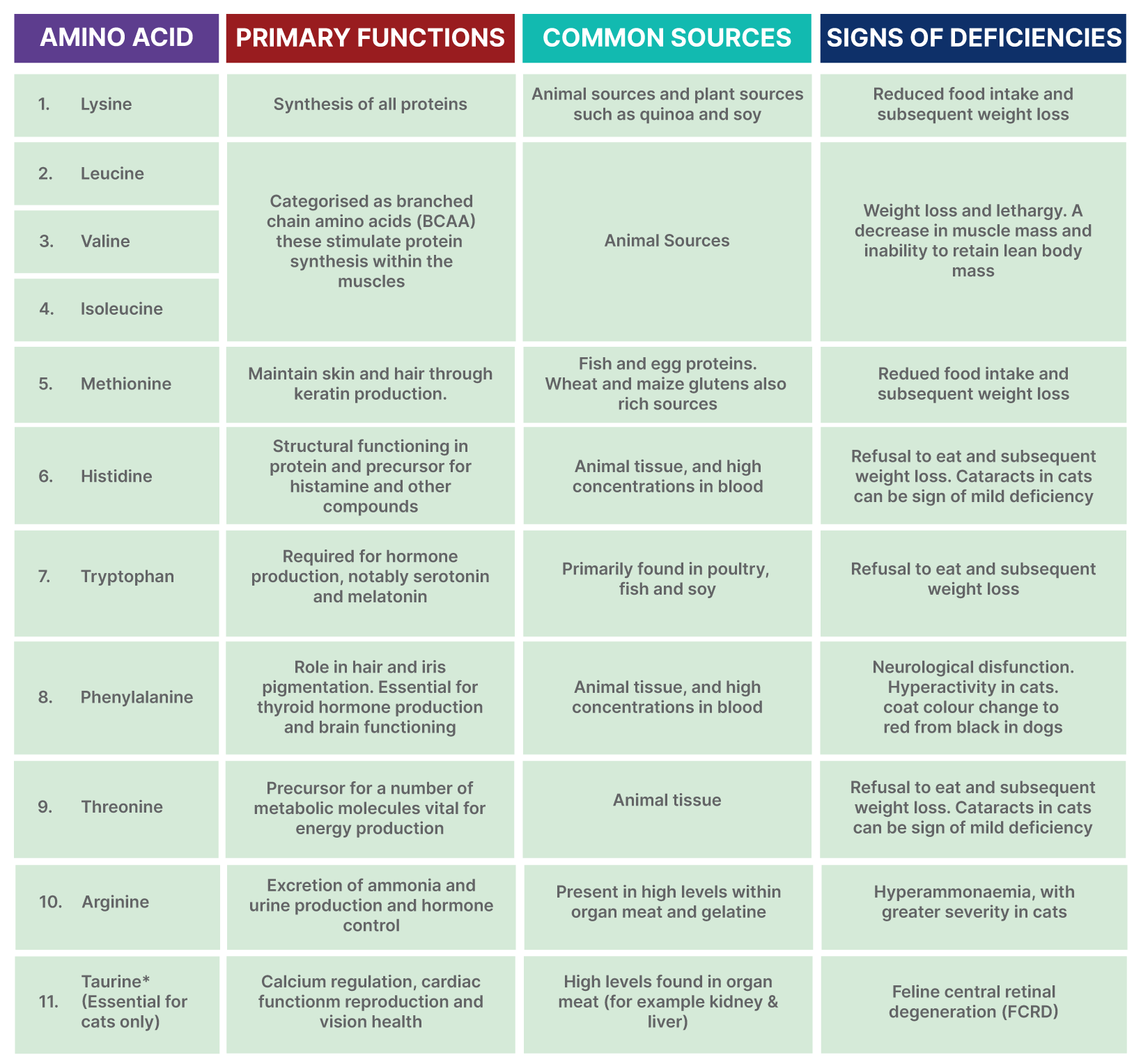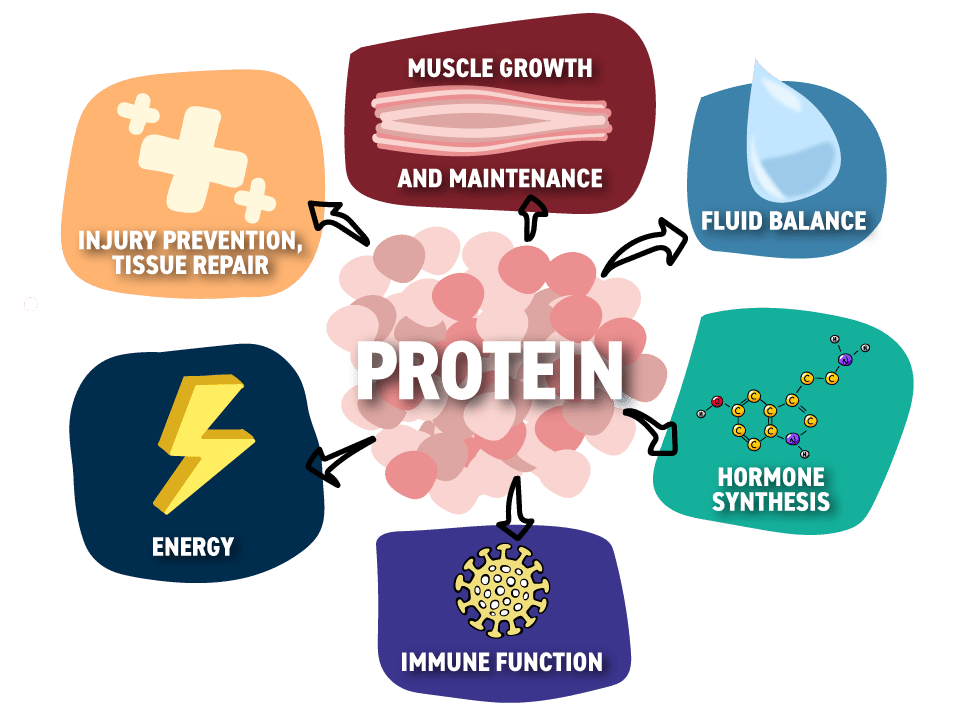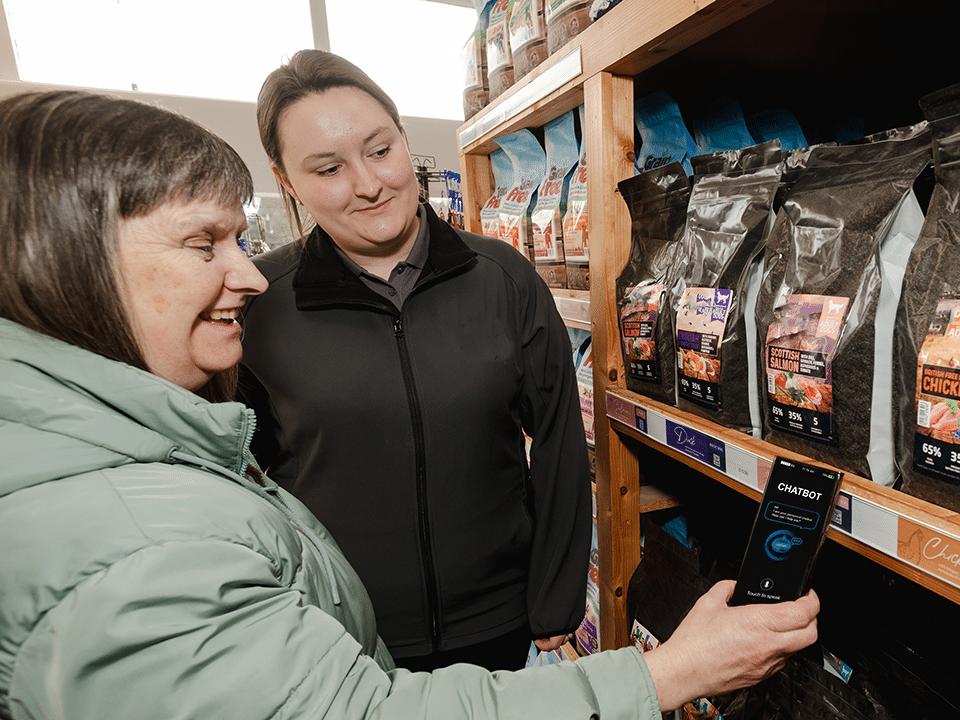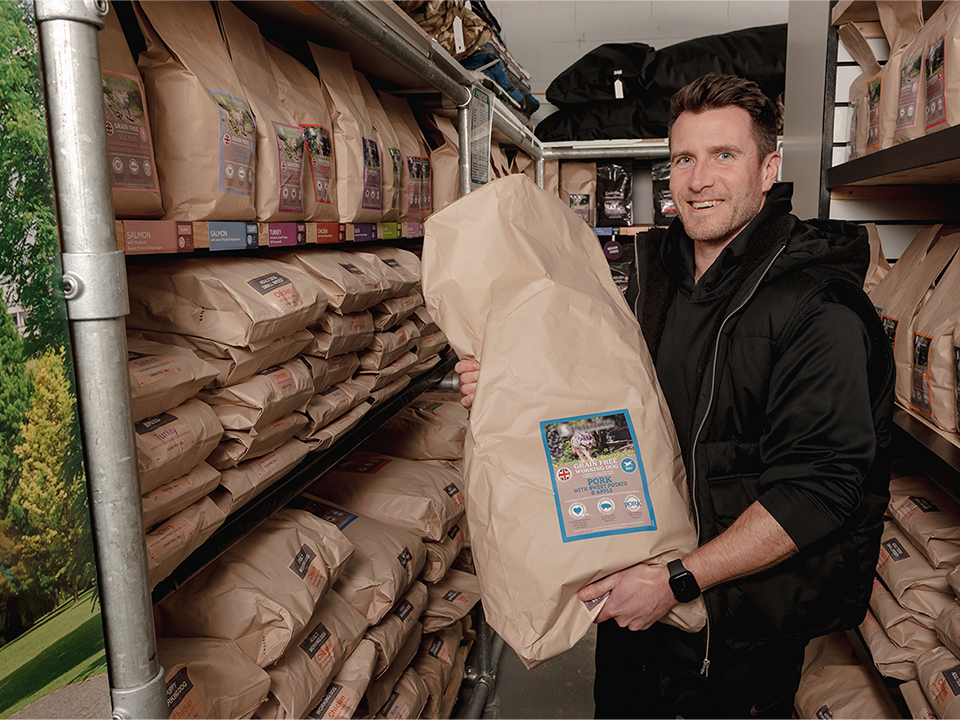
What is Protein?
Proteins are complex molecules present in all living organisms and provide many essential functions in the body. These molecules are formed through the ‘building blocks’ of 20 amino acids, which can be deemed essential or non-essential – those deemed essential cannot be synthesized in the body and must be obtained through dietary intake, whereas non-essential can be synthesized by the body through the metabolism of other amino acids. The number of essential amino acids depends on the species in question. For example, humans require nine essential amino acids (EAAs), whereas dogs require ten, and cats require eleven (Table 1).

Table 1: Essential Amino Acids for Humans, Dogs, and Cats.
Amino acids 1-9 are essential for humans, 1-10 are essential for dogs, and 1-11 are essential for cats.
N.B. Although taurine is a type of amino acid (β-amino-sulfuric acid), it is not incorporated into protein and is not considered one of the 20 protein building blocks.
The structure and function of a protein/peptide can vary greatly depending on the amino acid sequence (Fig. 1). Although there is no definitive rule, shorter chains of amino acids (e.g., 2-50) may be described as peptides, whereas proteins are considered to comprise 50 or more amino acids. A key role for many proteins is providing support and structure in the body, including the formation of muscle tissue, bone, connective tissue, skin, and hair (including aspects such as pigmentation). All enzymes within the body are proteins, carrying out various vital chemical reactions from breaking down starch in food (e.g., amylase) to repairing DNA (e.g., DNA ligase). Peptides and proteins are also responsible for the production of hormones, neurotransmitters, and other chemical messengers – which are all responsible for the transfer of information around the body to ensure correct biological processes and functions are carried out.

Figure 1. Some of the roles of protein in the body.
Within the body, proteins are in a constant state of breakdown and resynthesis (known as protein turnover) (Fig. 2). Protein molecules are broken down into amino acids, which can then be reused to build more protein. These endogenous amino acids are not, however, 100% available for the synthesis of new protein, as some may also be converted to other compounds such as glucose and dopamine. Therefore, an exogenous supply of amino acids – provided by dietary protein intake – is required to complement the endogenous amino acids and meet the body’s demand to synthesize new protein.
On occasions where the dietary intake of protein is insufficient to meet these demands, the process can become unbalanced, resulting in excessive breakdown of protein relative to protein synthesis within the body, which in turn can be detrimental to health and performance. In contrast, ensuring an adequate supply of dietary protein can allow for optimal performance of the body – for example, maintaining skin and coat integrity and supporting optimal immune functioning.

Figure 2. Overview of protein synthesis and degradation.
Protein Requirements of Dogs and Cats
As protein is essential for cell and tissue growth, this is reflected in a higher protein requirement during periods of rapid growth or increased demand, such as in young growing animals and during gestation/lactation. This higher requirement makes allowance for the additional demands of milk production, growth, and development. FEDIAF guidelines provide separate guidance on the protein levels recommended for early and late growth phases of puppies and kittens. Early growth in puppies has a minimum requirement of 25g/100g dry matter (DM) in the first 14 weeks (when growth rate is rapid), dropping to 20g/100g DM in the late growth period1. In contrast, kittens as obligate carnivores require a minimum protein inclusion of 28g/100g DM throughout the 9-12 months of growth1.
A higher protein requirement for cats compared to dogs is reflected throughout the life stages in FEDIAF guidelines due to cats having a heavier reliance on protein as an energy source, in comparison to dogs who can utilize alternate resources such as carbohydrates2. In cats, a minimum protein requirement of 25g/100g DM is advised for active adult cats, with a higher recommended requirement provided for indoor/neutered individuals1. FEDIAF guidelines for dogs state a minimum recommendation of 18g/100g DM for an active adult dog1, or 21g/100g DM for less active dogs.
Despite a common misbelief amongst pet owners3, a reduction in protein intake for senior pets is not advised. As the aging process progresses, it becomes increasingly challenging for the body to maintain lean body mass (LBM), and subsequently, a change in total body weight amongst aging pets is a commonly seen trend4. FEDIAF recommends that protein intake remains the same as adult recommendations5, however, Laflamme et al. (2005) recommend that in many cases an increase in dietary protein could be beneficial for aging pets, especially if the intake level of food has decreased6. As pets age, factors such as underlying disease impact the efficiency of protein metabolism, and if the dietary supply of protein is not sufficient, muscle protein may be broken down and utilized. Over a prolonged period of time, this can lead to sarcopenia in senior cats and dogs, subsequently impacting morbidity and mortality.
Beyond the Minimum Requirements; Advantages of Protein
As with all dietary components, ensuring the minimum requirements are met within the diet aids the health and well-being of pets. Historically, there has been a belief amongst many pet owners that feeding high protein diets could in fact be detrimental to health – with an association to increasing the risk of kidney problems. For healthy individuals, there is no evidence to support this. The exception to this would be dogs and cats with impaired renal function, and such individuals with pre-existing conditions may be advised to consume a tailored diet with a reduced level of protein to provide nutritional support for the management of a veterinary-diagnosed condition7.
So, what are the advantages of feeding above these minimum requirements?
- Fulfilling the energy requirements of an individual through a high level of protein in the diet can limit the need for the inclusion of other components such as fat. Therefore, feeding diets high in protein has been shown to be beneficial in facilitating weight loss in overweight dogs and cats.
- High protein diets can benefit ageing pets by providing an easily digestible source of energy and reducing the reliance on components such as fat to maintain LBM and aid longevity.
- Diets formulated with high levels of animal protein are likely to correlate to high levels of dietary collagen being present. Collagen is key to bone health and crucial to joint health, allowing for mobility and flexibility throughout the life stages. Collagen also plays a role in the maintenance of skin and coat health.
- A higher level of protein can aid muscle growth and repair, which may be of particular interest to owners of working or sporting dogs who have a high physical demand on a daily basis.
- Providing the body with an abundance of protein, and therefore amino acids, allows for the replacement and replenishment of cells across the body, thus aiding general health.
Protein Sources in Pet Food
Although the total crude protein level of a pet food serves as an indicator for adequate AA levels, it does not necessarily guarantee all requirements will be met. As each AA plays a different role within the body (see Table 1), FEDIAF nutritional guidelines provide detailed guidance on the AA breakdown required to reduce the risk of deficiency. Diet formulation must ensure a complete AA profile is provided to the pet, taking into account species and life stage requirements, which may require the use of additional synthetic amino acids being added to a formulation.
All pet food manufacturers are legally required to declare the crude protein level under the analytical constituent section of product packaging. It is important when comparing products on the basis of protein level to take into account not only the animal’s requirement but also the moisture content of the food to ensure a direct comparison (this is of particular importance when comparing kibble and raw feed).
The sources of protein used in pet food are becoming increasingly diverse, offering a wide variety of choices to the consumer. Traditional animal sources such as chicken, beef, and salmon can be readily found on retail shelves, while more novel proteins such as buffalo, rabbit, and kangaroo have all been included in modern pet food formulations. Often, these proteins are selected for their unique nutritional properties and the subsequent marketing opportunities they provide.
Plant-based proteins such as soya, pea protein, and corn gluten are increasing in prominence in modern formulations. Despite an initial misconception that plant-based proteins are low-quality and provide an inadequate supply of EAAs, it has been shown digestibility in both cats and dogs is not negatively impacted by the use of plant proteins8. If correctly formulated, plant proteins in conjunction with animal proteins, or as the sole protein source, can meet the protein requirements of both dogs and cats. Brown et al. (2009)9 fed a meat-free diet to working sled dogs with no negative impact on health or performance. The study demonstrates that providing the correct level of protein with a complete AA profile should remain a priority in diet formulation over the source of protein. However, although acceptance of plant-based proteins has increased amongst consumers, Dodd et al. (2019)10 highlighted that owner diets are a major factor in the motivation to solely feed plant-based diets to pets. Although many owners surveyed would consider feeding a plant-based diet if commercially available, only 1.6% of dogs and 0.7% of cats were fed solely on plant-based diets.
Mirroring the trends of the human food chain, customer perception of protein quality is increasingly influenced by the sourcing and procurement of raw materials. For animal produce, this has an increasing focus on welfare claims, provenance, and certification processes (for example, organic). This humanization has resulted in a premium market surrounding the marketing claims associated with protein sources. Nutritionally, in recent years, the pet food market has seen an increased consumer interest in high protein products, with further interest in fresh meat inclusion11. Many of these high protein products are marketed with a link to the ancestral roots of our canine and feline companions – but it is important to consider that the quality and bioavailability of the protein are just as important to its utilization as the total level within a product.
Summary
Protein is a vital component of any diet, regardless of the species or life stage of the animal. With industry guidelines ensuring that minimum requirements are met within the products on offer to pet owners, pet food manufacturers look to exceed these requirements and aid bioavailability in pursuit of optimizing the benefits provided to the animal. With a broad range of products on offer to owners, the crossover of trends from the human market provides unique selling points and novel attributes to aid product differentiation. Furthermore, research findings from human nutrition often have transferable links to dogs and cats, and this cross-species knowledge allows for the implementation of technological and processing advances to be utilized by the pet food industry – ultimately providing high-quality products to pet owners and aiding the health and well-being of pets.
References
- FEDIAF. (2021). Nutritional Guidelines for Complete and Complementary Pet Food for Cats and Dogs (pp. 1–98).
- Buff, P. R., Carter, R. A., Kersey, J. H., & Bauer, J. E. (2014). Natural pet food: A review of natural diets and their impact on canine and feline physiology. Journal of Animal Science, 92, 3781–3791.
- Hutchinson, D., Freeman, L. M., Schreiner, K. E., & Terkla, D. G. (2009). Survey of opinions about nutritional requirements of senior dogs and analysis of nutrient profiles of commercially available diets for senior dogs. International Journal of Applied Research in Veterinary Medicine, 9, 68–79.
- Pérez-Camargo, G. (2004). Cat nutrition: What is new in the old? Compendium on Continuing Education for the Practicing Veterinarian, 26, 5–10.
- FEDIAF. (2017). FEDIAF Scientific Advisory Board statement: Nutrition of senior dogs. Retrieved from https://fediaf.org/press-releases/2151-how-to-feed-a-senior-dog.html
- Laflamme, D. P. (2005). Nutrition for ageing cats and dogs and the importance of body condition. Veterinary Clinics of North America: Small Animal Practice, 35, 713–742.
- Elliott, D. A. (2006). Nutritional management of chronic renal disease in dogs and cats. Veterinary Clinics of North America: Small Animal Practice, 36, 1377–1384.
- Golder, C., Weemhoff, J. L., & Jewell, D. E. (2020). Cats have increased protein digestibility as compared to dogs and improve their ability to absorb protein as dietary protein intake shifts from animal to plant sources. Animals, 10, 1–11.
- Brown, W. Y., Vanselow, B. A., Redman, A. J., & Pluske, J. R. (2009). An experimental meat-free diet maintained haematological characteristics in sprint-racing sled dogs. British Journal of Nutrition, 102, 1318–1323.
- Dodd, S. A. S., Cave, N. J., Adolphe, J. L., Shoveller, A. K., & Verbrugghe, A. (2019). Plant-based (vegan) diets for pets: A survey of pet owner attitudes and feeding practices. PLoS ONE, 14, 1–19.
- Vinassa, M., et al. (2020). Profiling Italian cat and dog owners’ perceptions of pet food quality traits. BMC Veterinary Research, 16, 1–10.

Emma Hunt
GA Pet Food Partners Pet Nutritionist
Emma has an undergraduate in Animal Behaviour and Welfare and subsequently completed a Masters in Veterinary Public Health at the University of Glasgow. Following this, she worked in the agri-food industry for several years and kept her own sheep flock before joining GA in 2021. Emma enjoys training and competing in strong woman, or spending time with her much-loved collie Lincoln
You may also like...
Article written by Emma Hunt
The Pros and Cons of AI in Pet Retail
You may have frequently encountered the term “AI” or “AI technology” in the media. From unlocking your phone using Face ID, asking for directions on your [...]




